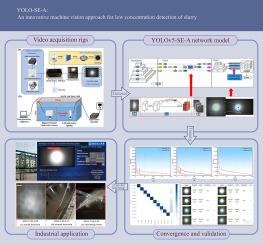YOLO-SE-A: An innovative machine vision approach for low concentration detection of slurry
IF 4.6
2区 工程技术
Q2 ENGINEERING, CHEMICAL
引用次数: 0
Abstract
Flocculation-sedimentation of coal slurry is vital for the efficient utilization of coal. However, the detection technology for low concentration clarification layers during the settlement process suffers limitations such as low accuracy and large lag times. Thus, the present work was aimed at developing a new machine vision method for the 0–1000 mg/L concentration range detection for slurry. Firstly, the high-quality video images were acquired with camera focus of 20 cm, distance between light and camera of 10 cm, and light intensity of 35 Klux. The process of Framing→Cropping→Bilateral filtering→CLAHE equalization→Weighted average grayscale→Mosaic augmentation was designed to obtain the feature dataset of slurry. Compared before and after processing, the RMS contrast, Laplacian variance, entropy and training-size of dataset increased 30.4 %, 1.2 %, 12.8 % and 25 %, respectively. Secondly, the combination of Squeeze-and-Excitation and Anchor boxes was embedded into the classical YOLOv5 model to develop a new YOLOv5-SE-A algorithm, which showed good convergence with object loss of 0.0016, classification loss of 0.0038 and bounding box loss of 0.0025. Compared to YOLOv5, the novel algorithm improved performance in Precision, mAP50, and Recall with increasing absolute values of 3.17 %, 3.27 %, 5.47 %, respectively. Thirdly, laboratory validation through accuracy analysis and confusion matrices confirmed the exceptional performance of YOLOv5-SE-A, with a 97.3 % average detection accuracy and a maximum 2.7 % misidentification rate. Compared to conventional YOLO architectures, the proposed model achieves superior metrics (97.38 % precision, 95.69 % mAP, 98.57 % recall) while sustaining real-time processing at 31 fps. Finally, the successful industrial application of YOLOv5-SE-A demonstrated its advantage and application potential.

YOLO-SE-A:一种用于低浓度浆料检测的创新机器视觉方法
煤浆的絮凝沉降对煤的高效利用至关重要。然而,对于沉降过程中低浓度澄清层的检测技术存在精度低、滞后时间大等局限性。因此,本工作旨在开发一种新的机器视觉方法,用于浆料浓度范围0-1000 mg/L的检测。首先,在摄像机焦距为20 cm、光源与摄像机距离为10 cm、光强为35 Klux的条件下,获得高质量的视频图像。设计了分幅→裁剪→双边滤波→CLAHE均衡→加权平均灰度→马赛克增强的过程来获得浆料特征数据集。与处理前后相比,数据集的均方根对比、拉普拉斯方差、熵和训练量分别提高了30.4%、1.2%、12.8%和25%。其次,将Squeeze-and-Excitation和Anchor boxes的组合嵌入到经典的YOLOv5模型中,开发了新的YOLOv5- se -a算法,该算法具有良好的收敛性,目标损失为0.0016,分类损失为0.0038,边界盒损失为0.0025。与YOLOv5相比,该算法在Precision、mAP50和Recall方面的性能分别提高了3.17%、3.27%和5.47%。第三,通过准确性分析和混淆矩阵进行实验室验证,YOLOv5-SE-A的平均检测准确率为97.3%,最高误判率为2.7%。与传统的YOLO架构相比,该模型在保持31 fps的实时处理速度的同时,实现了更高的指标(97.38%的精度,95.69%的mAP, 98.57%的召回率)。最后,YOLOv5-SE-A的成功工业应用证明了其优势和应用潜力。
本文章由计算机程序翻译,如有差异,请以英文原文为准。
求助全文
约1分钟内获得全文
求助全文
来源期刊

Powder Technology
工程技术-工程:化工
CiteScore
9.90
自引率
15.40%
发文量
1047
审稿时长
46 days
期刊介绍:
Powder Technology is an International Journal on the Science and Technology of Wet and Dry Particulate Systems. Powder Technology publishes papers on all aspects of the formation of particles and their characterisation and on the study of systems containing particulate solids. No limitation is imposed on the size of the particles, which may range from nanometre scale, as in pigments or aerosols, to that of mined or quarried materials. The following list of topics is not intended to be comprehensive, but rather to indicate typical subjects which fall within the scope of the journal's interests:
Formation and synthesis of particles by precipitation and other methods.
Modification of particles by agglomeration, coating, comminution and attrition.
Characterisation of the size, shape, surface area, pore structure and strength of particles and agglomerates (including the origins and effects of inter particle forces).
Packing, failure, flow and permeability of assemblies of particles.
Particle-particle interactions and suspension rheology.
Handling and processing operations such as slurry flow, fluidization, pneumatic conveying.
Interactions between particles and their environment, including delivery of particulate products to the body.
Applications of particle technology in production of pharmaceuticals, chemicals, foods, pigments, structural, and functional materials and in environmental and energy related matters.
For materials-oriented contributions we are looking for articles revealing the effect of particle/powder characteristics (size, morphology and composition, in that order) on material performance or functionality and, ideally, comparison to any industrial standard.
 求助内容:
求助内容: 应助结果提醒方式:
应助结果提醒方式:


